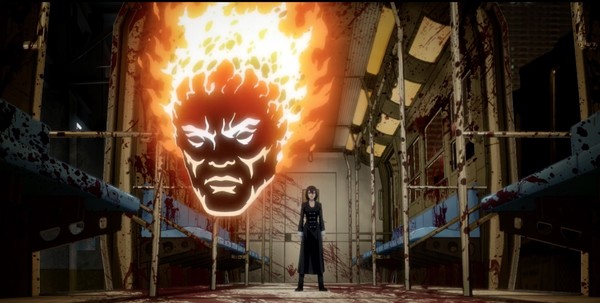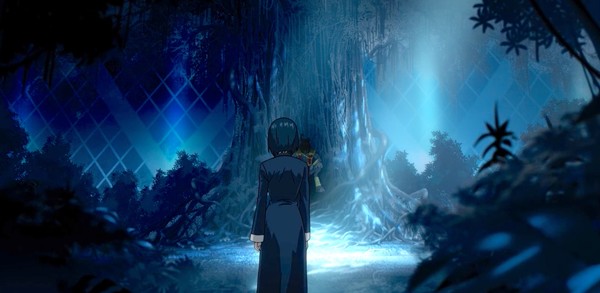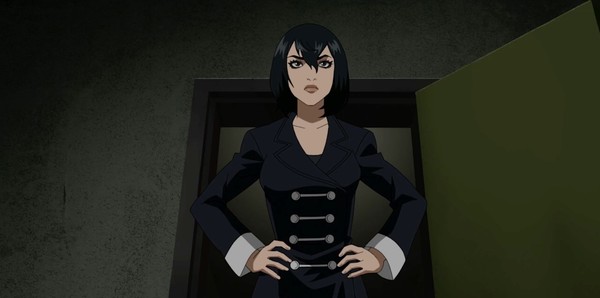Bringing Manila Folk-Horror to Life: TRESE Director Jay Oliva, Creators Kajo Baldisimo and Budjette Tan
by Rafael Antonio Pineda,Based on the Filipino graphic novel of the same name by Budjette Tan and Kajo Baldisimo, the Netflix Original Anime Trese follows detective Alexandra Trese as she takes on the supernatural criminal underbelly of the city of Manila, where the mythical creatures of Filipino folklore live in hiding amongst humans. Anime News Network had the opportunity to interview showrunner and director Jay Oliva, as well as Trese's creators Kajo Baldisimo and Budjette Tan, about the unique process of bringing the award-winning graphic novel to life.
Trese is quite different from the rest of your work, which seems to be focused on Marvel and DC comic adaptations. What persuaded you to work on a Filipino dark urban fantasy story?
Jay Oliva: I don't think it's different for me – this is still an adaptation of a graphic novel, and for me it's going into a dark, mysterious world that is very similar to what we did with Constantine and Justice League Dark.
What attracted me to Trese was that I am Filipino, and I've never had an opportunity to work on something truly based in the Philippines and Filipino lore. That was a very exciting proposition to me. My family comes from the Philippines, and there's a tremendous sense of honor knowing I could be one of the first creators to translate this type of material for a worldwide audience. And it feels like my entire career has set me up to do this – because I really felt that I could bring something authentic to this comic that some others might not be able to do. I've worked with iconic characters in the past – from Batman to Spider-Man and many others – and this story and these characters felt like an extension of so much of that work. With a Filipino spin.
The detail in the Manila background art in the trailer has had many people commenting on how close the art is to capturing everyday (or nightly) Manila. What kind of work went into location research for the show?
Our art director Jojo Aguilar and I traveled to Manila in December 2018 for a story summit with the writers, and we toured all the locations in the comics to get as much reference as we could. We really wanted to make Manila a character unto itself in this series, and to take these real-life locations and see them through the lens of Trese – in order to keep the heritage and authenticity from within the original comics. Jojo is also Filipino, so he really knows how to capture and romanticize the city, and so I think we were able to depict the city and its people quite well.

The stories shown in the trailer appear to mostly be from the first three volumes of the comic. How did the staff go about deciding which stories to adapt from the comic?
We did a story summit with the writers where we discussed all the comics, and the differing perspectives gave us a wide overview of what the series should be. The writers were all well-versed in the comics, but I was relatively new to the material, so I asked a lot of questions. And we quickly realized that the way the stories in the comics play out, there are a few volumes and then a big moment, and that arc repeats itself – giving us nice story breaks for the animated series. So that's how we chose which volumes to incorporate into the first season. That approach also makes it more accessible to people coming into the series with no background in the comics, while also giving the comics' fans a piece of entertainment that offers both familiarity and some things that will be a little different. And that should benefit everyone.
The Filipino dub for Trese has gotten many approving remarks. What was the casting like for the Filipino dub, and also for the English dub (which also has a heavy Filipino and/or Fil-Am presence)? What was the overall direction for the acting?
We tried to keep the voice direction as authentic as possible, so we did reach out initially to primarily Filipino-American and Filipino-Canadian actors, because we definitely wanted to use Filipino accents in the English-language version. That was easy for our Filipino actors and, for those who didn't have the accent naturally, like Steve Blum and Matt Yang King, we sent them reference materials. They're actors, so that's what they do – act and become other characters.
For the lead role, we felt it was important that both the Filipino actress and the English-language actress were able to embody Alexandra. It wasn't enough to just have the accent – she needed to really match well with Alexandra's presence and attitude. Honestly, we didn't think we could get Liza, and we were so thrilled to get Shay. Both of them absolutely nailed the role, and both also helped us better inform the character. From leads to supporting roles, though, this really is a dream cast.

UDD for the theme song of the series also surprised many when it was revealed a few days ago, and I'm sure the band was only one among many other choices. What made UDD a good fit for the project?
When we had our initial meeting with UDD, we gave them the series pitch, but we only gave them enough direction to get them started – and not hinder their creativity. Basically, we gave them a broad overview of the tone of the series, and told them we wanted something that was haunting, but also would cleanse the viewers' palette at the end of each episode – because our endings can be a bit jolting. And they did it. When they played us their first take, we knew it was the one that we wanted. It just needed a little refining, but it was a home run right off the bat.
Which Filipino folklore creatures in Trese were your favorites in the show in terms of design and depiction? Were there any creatures that you heard childhood stories from, or ones that scared you?
I know it will seem like I'm cheating, but I think – all of them are my favorites. I really love bringing these creatures to life. We took our cues from the comics. Like for the Tiyanak, we did opt to go a little different from the comics. I fell back on my love of the horror films, and leaned into John Carpenter's The Thing – choosing more along the lines of creepy and weird. And also for the Tikbalang, the horse people – these 10-foot-tall half-man, half-horse creatures – I didn't want to go that route. This is one of those supernatural races that existed, but had to go into hiding. I wanted them to be confused that they look like men who look like horses. So we focused on the details, like making their faces horse-shaped, but in a more exotic, beautiful way.

The main character Trese has a very sharp look and distinct silhouette. How did you come up with her design, and what traits of Trese does her design try to emphasize?
Kajo Baldisimo: The hairline was based on my own. The coat was inspired by the national hero of the Philippines, Jose Rizal.
The comic can shift readily between detail-filled backgrounds to sparse, abstract panels that use a lot of negative space art, while the Netflix series seems to have constantly detailed backgrounds. Do you think some of the visual tone might significantly change because of this, and in what way?
The art style of the comic books change based on the story being told and also because of how I feel at the moment the page is being made. I think they have a different set of standards in the creation of the animation so they will be more consistent than I am.

There are some unique looks to a lot of the Filipino folklore monsters in the story, different from their usual portrayals in other works. What do you draw from in some of the monster designs?
My designs for the creatures in Trese are just a mishmash of images retained from my childhood. I guess years of devouring komiks and local horror TV shows allows one to collect various ingredients to create, if not a unique soup, at least a savory one.
The visualization of Manila in both the comics and the series is a city of high contrast lighting, with a lot of humble places nestled in between mid-high rise buildings. Which specific parts of Metro Manila are your favorite to reference when exploring this style?
I was born and raised in Makati city. That was mostly the inspiration for the neighborhoods Trese operated on in the komiks. The high contrast of light and dark, rich and poor is very accurate description of this city I grew up in.
Which Filipino folklore creatures in Trese were your favorites to draw in the story? Were there any creatures in particular that scared you from childhood stories?
The manananggal is never pleasant but probably the most interesting, but the tikbalang and the nuno are, maybe, my favorites.
How involved were you in checking scripts for the series? Were there any major story changes that you or the show writers (or both!) pressed for?
Budjette Tan: When Jay Oliva and Tanya Yuson started the writer's summit in Manila, we were not involved in that writing process. I got to meet Jay and the team via video call and we chatted about the characters and the world of Trese. Kajo was able to fly in and spend a day with Jay and Jojo Aguilar, the art director of the show, and they talked about character designs and the look of the city. And after those Q&A sessions, Jay and the team went on their way to develop the story for the anime. If you've read the comic book, then I think you'll see which stories were picked from the first 13 cases, how they were merged and mixed and matched with other stories. And you'll also see how they made major changes in some of the characters and story arcs. And I feel all these changes were made to tell the story better, now that Trese was being adapted into the animated medium.

There are some other notable Filipino works that mixes local folklore with modern day life, but Trese is unique in its noir urban fantasy tone. What pointed you towards writing Trese this way?
Trese's pulp noir/urban fantasy tone came from a love of Batman, John Constantine, X-Files, CSI, Twilight Zone and growing up in Manila – where we are told stories by our parents and grandparents of supernatural creatures that live in trees and underground. Manila is filled with urban legends, 400-year-old churches, and haunted houses. So, with all those thrown into the mix, we created this detective/police procedural story where our heroine investigates supernatural crime in modern Manila.
Despite the larger-than-life elements from folklore, many of the Trese stories draw from many mundane and familiar street stories and local history in Manila. How much do you draw from Manila “true crime” when writing the stories?
A lot of the Trese cases are based on Manila's urban legends, stories I've heard from family and friends, and yes, stories that have popped up on newspaper headlines. Back in the 90s and 2000s, I also read the Metro section a lot, which is where they would have some short report about some unsolved crime.
Which Filipino folklore creatures in Trese were your favorites to write about? Were there any in particular that have scared you from childhood?
When I first saw the manananggal in the movie Shake, Rattle, and Roll, that scared me as a kid! And maybe that's one of the reasons I keep writing about it. I still feel that I have more mananggal stories to tell in the pages of Trese.
You wrote Trese in English originally, and while Bob Ong has written a Filipino translation, this is the first time these stories have also had voices in full Filipino attached to them. What does it feel like to hear your story in the local vernacular?
It's great to hear the words that I wrote now being spoken on screen and to hear them in the same way I've been hearing these voices in my head all these years. It's also wonderful to hear Trese's story told in Filipino. Some moments, some dialogue just hits home more.
Trese is the first major Filipino pop-cultural work to get a Netflix animated series, and a lot of Filipino writers are definitely paying attention to it, and to you. What does it feel like now, and is there anything you want to say to this audience?
What do I want to say to this audience? Please watch Trese! Please watch it in English and Filipino!
But seriously… what I'd like to say is… and I will borrow Neil Gaiman's words here… is to trust your story. Tell the story that you've always wanted to tell and trust your story, wherever it takes you.
Kajo and I started Trese in 2005 and after all these years, we are finally reaching a global audience. I feel we were able to get here now because we never stopped working on this little story that we wanted to tell.
Trese premieres on Netflix on June 11
discuss this in the forum (5 posts) |